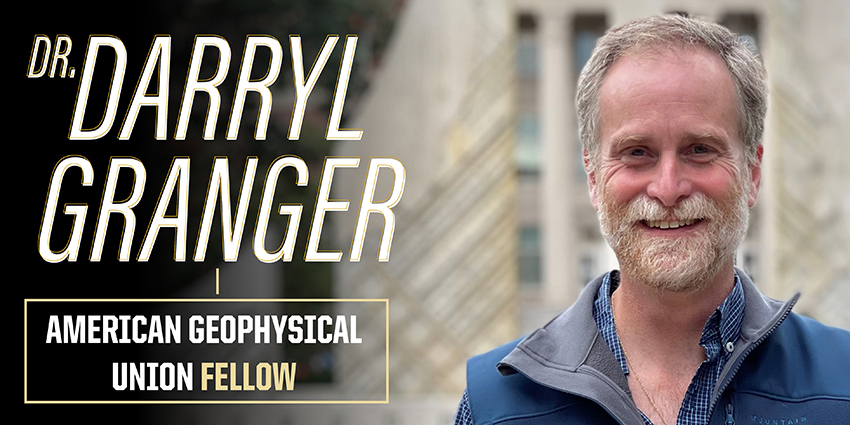Darryl Granger elected 2021 AGU Fellow
09-28-2021

Dr. Darryl Granger, Purdue University Department of Earth, Atmospheric, and Planetary Sciences (EAPS) professor, was elected as an American Geophysical Union’s (AGU) Fellow. He joins 59 other individuals in the 2021 Class of Fellows. Since 1962, the AGU Union Fellows Committee has selected less than 0.1% of members as new Fellows. AGU, a nonprofit organization that supports 130,000 enthusiasts to experts worldwide in Earth and space sciences, annually recognizes a select number of individuals as part of its Honors and Recognition program.
According to the AGU, “Granger was selected because he made outstanding achievements and contributions by pushing forward the frontiers of our science. He also embodies the AGU’s vision of a thriving, sustainable, and equitable future powered by discovery, innovation, and action. Equally important is that he conducted himself with integrity, respect, and collaboration while creating deep engagement in education, diversity, and outreach.”
“When I look at the list of AGU fellows I see a lot of people I look up to and admire, who have inspired me and my work. It’s a real honor to be elected to this group,” says Granger. “One thing that makes this award very special to me is that I learned that my nomination was encouraged by some of my younger colleagues both here at Purdue and elsewhere. It feels special to be honored by my peers at AGU, but more special to know that the honor came from this younger generation of scientists as well.”

Granger works at PRIME Lab, the Purdue Rare Isotope Measurement Laboratory, an accelerator mass spectrometry facility on campus. He works with cosmogenic nuclides, which are the products of rare nuclear reactions inside mineral grains due to cosmic rays, high-energy particles that bombard Earth from space. Basically, he counts atoms in mineral grains to figure out how long a rock has been either near the surface or buried underground. PRIME Lab at Purdue is one of a small number of facilities in the world that are capable of making this type of measurement. The longer a rock is exposed at the surface, the more of these cosmogenic nuclides accumulate. If a rock is buried underground, then whatever cosmogenic nuclides accumulated before it was buried then decay over time due to radioactivity.
“What these methods have allowed us to do is to learn about how fast the land surface is eroding over time, and how erosion rates depend on factors like climate or mountain-building. I’ve been lucky to work all over the world to help learn how landscapes evolve over time,” says Granger. “The other thing we can do with cosmogenic nuclides is date rocks that were buried underground, such as in river terraces or in caves, over timescales reaching back to 5-6 million years. I’m probably best known for my work in caves, which provide a unique window on landscape history. Caves such as Mammoth Cave in Kentucky can tell us about the whole landscape’s response to the ice ages over the past few million years. One of the most interesting and exciting topics I’ve been able to work on is human evolution and archaeology. For example, with my colleagues I’ve been able to date famous fossil sites such as Peking Man at Zhoukoudian, China, and Little Foot at Sterkfontein, South Africa. We’ve worked at archaeological sites across China and extended the evidence for early humans in Asia back in time.”
He is originally from Huntsville, AL and received his B.S. in Physics and Scientific Instrumentation from Carnegie Mellon University in Pittsburgh, PA. Then he went to graduate school at U.C. Berkeley and received a Ph.D. in geology. In 1996, he came to Purdue University to teach. This November marks 25 years of teaching excellence for Granger.
The AGU stated in a letter to Granger that he has “advanced discovery and solutions in geosciences.”
Granger says, “I think one of my contributions to science is that I have come up with new methods that have proven to be pretty useful, and so others have built on my work. I think my other contribution has been reaching out to work across disciplines, for example into archaeology and human evolution.”
The AGU will formally recognize this year’s recipients, including Granger, during #AGU21 Fall Meeting, December 13-17, 2021, in New Orleans, LA and online everywhere. This celebration is a chance for AGU’s community to recognize the outstanding work of their colleagues and be inspired by their accomplishments and stories.
AGU press contact:
Nanci Bompey, news@agu.org (UTC-4 hours)
AGU (www.agu.org) supports 130,000 enthusiasts to experts worldwide in Earth and space sciences. Through broad and inclusive partnerships, we advance discovery and solution science that accelerate knowledge and create solutions that are ethical, unbiased and respectful of communities and their values. Our programs include serving as a scholarly publisher, convening virtual and in-person events and providing career support. We live our values in everything we do, such as our net zero energy renovated building in Washington, D.C. and our Ethics and Equity Center, which fosters a diverse and inclusive geoscience community to ensure responsible conduct.
Writer: Cheryl Pierce